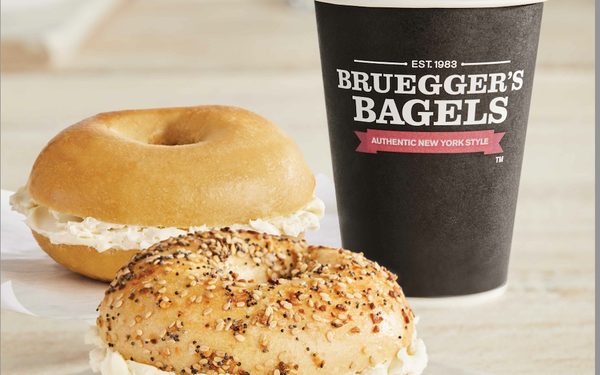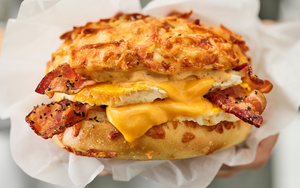
QSR breakfasts are booming.
While egg prices have impacted more fast-casual breakfast chains like Waffle House, which was forced to implement a 50 cent per egg surcharge, fast-food breakfasts are still on the uptick.
One
possible reason is that breakfast can be considered a small indulgence. High food prices and lingering recession fears had Americans gravitating toward buying breakfast as a budget-conscious splurge
in 2024, according to Technomic, a food industry consultancy.
The morning hour daypart has experienced the most increase in foot traffic over any other time since 2019, and pre-lunchtime hours
accounted for 21% of total restaurant visits in 2024, per market research firm Circana.
This trend isn’t expected to slow down. The QSR breakfast takeout market is predicted to grow from
$109.6 billion in 2025 to $213.7 billion by 2035, per a recent Future Market Studies report.
advertisement
advertisement
One chain that knows a thing about breakfast is Bruegger’s Bagels, as the morning daypart
(defined as between 7 A.M. and 11 A.M.) accounts for 60% of the chain’s business, serving such items as Double-Stack Egg Sandwich on a Cheesy Hash Brown Gourmet Bagel.
The Denver-based
chain’s director of marketing, Kate Savelli, told QSR Insider about morning customers and the growing trend of “stacked” options to add value to menus.
QSR
Insider: Why do you think breakfast is experiencing such growth right now?
Kate Savelli: Breakfast has been growing rapidly over several years because it is truly a
daypart that our guests use to add value to whatever their day has in store. Before the pandemic, when people were on the go to work, the gym, class, etc., breakfast “out” offered a
convenient way to fuel up for the day that was easy to grab and take on the go.
During the pandemic, we saw consumers gravitate towards later breakfast hours and brunch, as breakfast evolved
from just a quick bite to a chance to enjoy a fulfilling meal at the start of the day.
Now, with rising inflation, breakfast offers an affordable way to treat oneself, be it coffee and a
… bagel, or a hearty egg sandwich that you know will get you through lunch. Breakfast is the daypart that we in the industry can really see consumers using differently as their lives and
routines change.
QSR Insider: Is there a perception of more value with breakfast?
Savelli: While breakfast dollar-to-dollar is more affordable than lunch or
dinner, consumers also expect it to be. That presents us in the industry with a marketing conundrum: We have the price value, but we don’t get all the credit for it!
It’s when we
recognize that time is often the most valuable commodity in our guests’ busy routines that we can build that brand loyalty by delivering a consistent, timely, and of course, delicious
experience.
Speaking of consistency, no one wants surprises when they are just getting their day started. Our guests love it when we add new items to our menu…. But ensuring we deliver
that new sandwich just as deliciously every day is really what our guests demand.

QSR Insider: The "stack" term is becoming increasingly popular with
burgers, sandwiches, and now bagels. Why do you think that is?
Savelli: The word “stack” carries strong visual appeal, conjuring up images of tall, layered creations that
evoke a sense of indulgence. This aligns perfectly with what today’s customers are looking for: food that’s both filling, chef-driven, and photo-worthy.
QSR Insider:
What is it about the concept that's more appealing to customers rather than say a "double" or "large"?
Savelli: While “double” often suggests simply more of the same, with
our new menu item -- the Double-Stack Egg Sandwich -- what truly resonates with customers goes beyond just size. The concept conveys abundance, value, and indulgence, signaling a bold and satisfying
experience. The name Double-Stack also carries a craveable, nostalgic tone that taps into the comfort of classic American fare. It’s not about being bigger, but really offering a layered,
memorable experience that feels genuinely worth it.